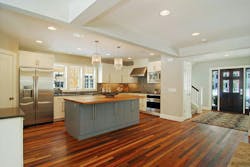13 Products That Will Make Your Houses Better, More Efficient
Some builders and remodelers have grown weary of the term “green,” but making houses energy efficient, healthy for inhabitants, and cheaper to operate are still worthy goals to pursue.
Use whatever term you like—green, sustainable, high performance, etc.—but some products are “better” and offer more benefits than others.
One of the complicated aspects of building a better home is finding the products that fit within your budget, offer a reasonable financial payback, or contribute to the comfort of your buyers.
Identifying a green material depends on your idea of sustainable, however, and it’s largely based on how you assess products. This can (and does) lead to confusion. Things become even more difficult when you consider cases of greenwashing in the building products industry.
Generally speaking, a product that helps save energy or water can be considered green. A material that doesn’t harm the environment also qualifies. The California Department of Resources Recycling and Recovery says green building materials are made from renewable sources and are environmentally responsible because their impact is considered over the life of the product.
Moreover, green products include items that are made from recycled content and manufactured using a resource-efficient process. It’s ideal if they come from local or regional sources and can be reused or recycled at the end of their lives. And products that are nontoxic—low-VOC paints and stains, for example—also are preferable.
One often-overlooked characteristic of a green product is cost, says the University of Kansas School of Architecture and Urban Design. Green products should not be “significantly more costly than their counterpart conventional building materials,” the university writes. “Payback period (initial costs recouped through lower long-term operating and maintenance costs) is reasonable. Green building products will not become mainstream until they are ubiquitous in the marketplace, which will happen largely due to costs comparable to traditional counterparts.”
Still, green consultants, builders, and architects differ on how products and materials should be assessed. Some professionals, for example, prefer not to use petroleum-based vinyl building materials and products, such as siding, decking, windows, and doors, but other pros favor such products because they are often affordable, sometimes made with recycled material, and usually require little maintenance or refinishing. They also disagree on the sustainable merits of various insulation types.
Complicating matters further, a product may be safe for the environment and have been manufactured with nontoxic materials, but it may require frequent maintenance. Is it still sustainable? As noted architect Peter Pfeiffer has said, low-VOC paints or finishes make no sense if you have to repaint frequently. And what if a product is energy-intensive to manufacture but helps make houses energy efficient? Does it qualify? Similarly, some products that are hailed for their green benefits require the energy-intensive mining of natural resources.
Just because choosing green products requires some work is not a sound reason to shirk your responsibility to use them. Building a quality house involves appropriate site orientation, good design, and sound construction, but it also needs the right products to help save energy, water, and promote good indoor air quality.
“It’s all important,” says green builder William Moore, of William T. Moore, in Austin, Texas. “If you don’t consider all the issues, you are doing it halfway.” The complicating part of the answer is that every house in every region and every sub-region has its own specific set of possibilities. “For instance, I would build high-mass walls in an arid climate with large temperature swings,” Moore explains. “I would build low-mass, highly insulated walls in a warm, humid climate. If you are using standard wood framing, then for each region there is a different way to do the vapor barrier or you will cause the house to grow mold inside the walls.”
Manufacturers have become adept at developing cutting-edge products that make some decisions easier for builders and architects. From appliances to water heaters, air conditioners to toilets, a greater number of products are more fully formed than 10 or 15 years ago. Plus, many products now have designations or certifications from organizations such as GreenGuard, Living Building Challenge, the Department of Energy, Home Innovation Research Labs, and Cradle to Cradle, among others.
But green products should no longer even be a separate category; they should be standard, a part of everything you do. “The products we consistently specify these days are more focused on energy efficiency and high performance,” says Phil Kaplan, principal of Kaplan Thompson Architects, in Portland, Maine. “Many things we used to worry about, such as low-VOC content and low-water-usage fixtures, have started to become the norm.”
Here are some products that will help you build better houses:
